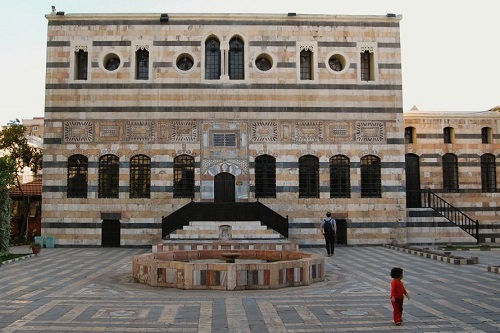Three hundred years ago a new era began in the life spring of architecture in Damascus. Damascene craftsmen released their imaginations free to create new designs and decorations to be used in hand written manuscripts, in table and bed cloths, in brocade and in metal carving. The magic of their creations appear clearly on house facades, around shaded courts and ponds and on the walls and ceilings of Damascus palaces and houses.
During the 19th century new styles and methods were introduced, borrowed from the western baroque style that prevailed in Europe at that time. Remains of which are still very clear in houses hat survived the effects of time. Since decorated stones and stucco masterpieces are fragile to the hazards of nature, some houses lost their brilliance and colors, a fact that instigated craftsmen to excel in the art of restoration so that they can save an old tradition from loss. Below are example of some of the portraits and paintings of artists who tried to depict aspects of the genuine architecture in old Damascus, with the comments of foreign and Arab scholars on these masterpieces.
As soon as we approach Damascus gardens become wider….water flows among stones glittering like a crystal veil…. No other oasis can stand to that of Damascus all round the world. From the top of Mt. Qassyoun we see Damascus as elegant as always, flat roofs, and protruding minarets in the midst of a green carpet with a small emerald green lake….”
In his book From Old Damascus of the Thirties_ Salesmen Calls) Dr. Cossio Glo says:” There are no facades, just very high walls with latticed windows and low gates….Artist Ch. Runo in his book (From Athens to Ba’albak) says: “The inner courtyard is very interesting. In the middle, it has a marble mosaic pond with citrus and jasmine trees…so that the Damascene man can enjoy smoking his water pipe….”
Dr Nadia Khost in an article of 1988 says: “These arts made the house larger….with an iwan…and the carpet-like marble ground floor fit harmoniously with furniture. Chairs are inlaid with mother of pearl, embroidered cushions, food served on carved copper trays..plates made of silver plated brass, and the clothes are made of embroidered tissues and normally kept in Arabesque wooden wardrobes.” * Western facade of Beit Sibai. J. Marki in his book “Islamic Arts” 1946 says: “Light falls on large areas to enflame the brilliant colors….the simple naked faÁades, and the little protrusions lightly inlaid with mother of pearl or marble and the complex stalactites form typical decorations for columns and arches.”
“A corridor leads to a marble tiled court and an iwan, covered with kelims, with a pit formed like a Gothic arch where water pipes, coffee cups, rose water jars and a censer..are displayed” * A corner in a courtyard (Beit Khattab-Souk Sarouja) scholar Valerie says: “We passed a corridor to reach a corner in the courtyard where there is a well. Only those excellent in decoration can create such wonderful designs..”
“Ground floors of the rooms are usually of two levels separated by a 50 cm step. The higher level is called ‘tazar’ covered with mats and carpets where as the lower part is called the threshold. It is tiled with mosaic marble and pieces of colored stones, and in the midst of which there is a marble pond”. Doors are small and low, topped with decorations that fit the inside decorations. Rooms have only one door. Outdoors are part of the quarter’s general style.”
Most windows looking at courtyards are fitted with lilac wooden grids or iron bars. Glass panel windows were used in Damascene houses in 1850s. Outdoor walls are built of alternative black and lime white rows called al Ablaq”. Marble ponds were built in the thresholds of large rooms to enjoy their wonderful designs and to cool the room temperature by the act of evaporation “.
After crossing the threshold of the room, eyes gradually get used to the light shade where the magic of decorations dazzles and attracts the sight, something that could be seen only in the manuscripts of the Middle Ages”. These pictures are just samples from the arts of the 18th century craftsmen, not only of Damascus, but of Aleppo, Hama, Sweida and the coastal cities of Syria. The Damascenes realized how precious and valuable their houses are, so they tended to change them into luxurious restaurants frequented by tourists as well as local people. To see more of these portraits see Gerard Rubin’s book “Palaces and Houses of 18th Century Damascus” sponsored by the French Institute of Arabic Studies and published by the Ministry of Tourism in 1990.
Haifaa Mafalani

